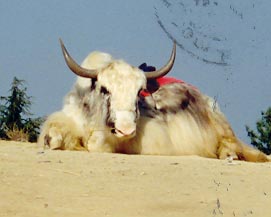WILD YAK -
Scientific Name:
Bos grunniens

Photo Brent Huffman
Status and Trends
IUCN Categories
1960's: Endangered
1970's: Endangered
1980's: Endangered
1994: Endangered
1996: Vulnerable;
2000: Vulnerable; (Population Trend: Decreasing)
Population Estimates:
[Note: Figures given are for wild populations only.]
WORLD
1995: A preliminary estimate of around 15,000 (Schaller 1998)
Countries Where It Is Currently Found:
2000: Occurs in China and India. May be extinct in Nepal. (IUCN 2000)
Distribution:
The wild yak was once numerous and widespread on the entire Tibetan plateau north of the Himalayas, in central China, India (Ladakh), Bhutan and Nepal. By around
1970 it was thought to occur only in remote areas, mainly in the northern and especially the northeastern parts of Tibet above 4000 m (13,000'), with a few animals still existing in Sikkim. Currently it is found in remote areas of the Tibetan plateau and adjacent
highlands, including Gansu Province, China, with a few having been observed in the Chang Chenmo Valley of Ladakh (eastern Kashmir, India). Wild yak distribution is highly clumped, with most animals in widely scattered herds, concentrated in the areas with
little disturbance by humans. For the most part, the wild yak's eastern limit now lies at the transition zone between alpine meadow in the east and alpine steppe in the west. From here its range extends westward through southwestern Qinghai Province, China.
The western limit of the wild yak's distribution lies between the Karakoram and Kunlun Ranges in an area known as the Aksai Chin. (Oakland Zoo, Schaller 1998)
Threats/Reasons for Decline:
Pic. Of domestic yak by Saurav Ghosh
 Uncontrolled hunting is the main reason for the wild yak's decline. Its range has been reduced by more than half during this century. Poaching remains the
main current threat. The wild yak has lost most of the best alpine meadow and steppe habitat to pastoralists. Problems are also caused by habitat disturbance, hybridization and competition with domestic yaks, and disease transmitted by domestic yaks.
Uncontrolled hunting is the main reason for the wild yak's decline. Its range has been reduced by more than half during this century. Poaching remains the
main current threat. The wild yak has lost most of the best alpine meadow and steppe habitat to pastoralists. Problems are also caused by habitat disturbance, hybridization and competition with domestic yaks, and disease transmitted by domestic yaks.
Facts about wild yak
- The wild yak grazes on grasses, herbs and lichens.
- It survives the long winter months by eating very poor, coarse grass and withered leaves and twigs, quenching its thirst with snow and ice.
- The yak was probably domesticated in Tibet during the first millennium B.C., and domesticated animals now occur throughout the high plateaus and mountains of
Central Asia, in association with people. Yaks found in zoos are usually of the domesticated variety, which is smaller than the wild yak. There are now more than 12 million domestic yaks in the highlands of Central Asia.
- The wild yak is supremely well adapted to the harsh highlands with its thick coat, great lung capacity, and ability to clamber nimbly over rough terrain. Even
its blood cells are designed for high elevations - they are about half the size of those of cattle and are at least three times more numerous, thus increasing its blood’s capacity to carry oxygen. Its thick coat and low number of sweat glands are also efficient
adaptations for conserving heat. (Schaller 1998)
- In winter the yak survives temperatures as low as - 40 deg C (- 40 deg F).
- Wild yak herds travel on snow in single file, carefully stepping on footprints left by the lead yak.